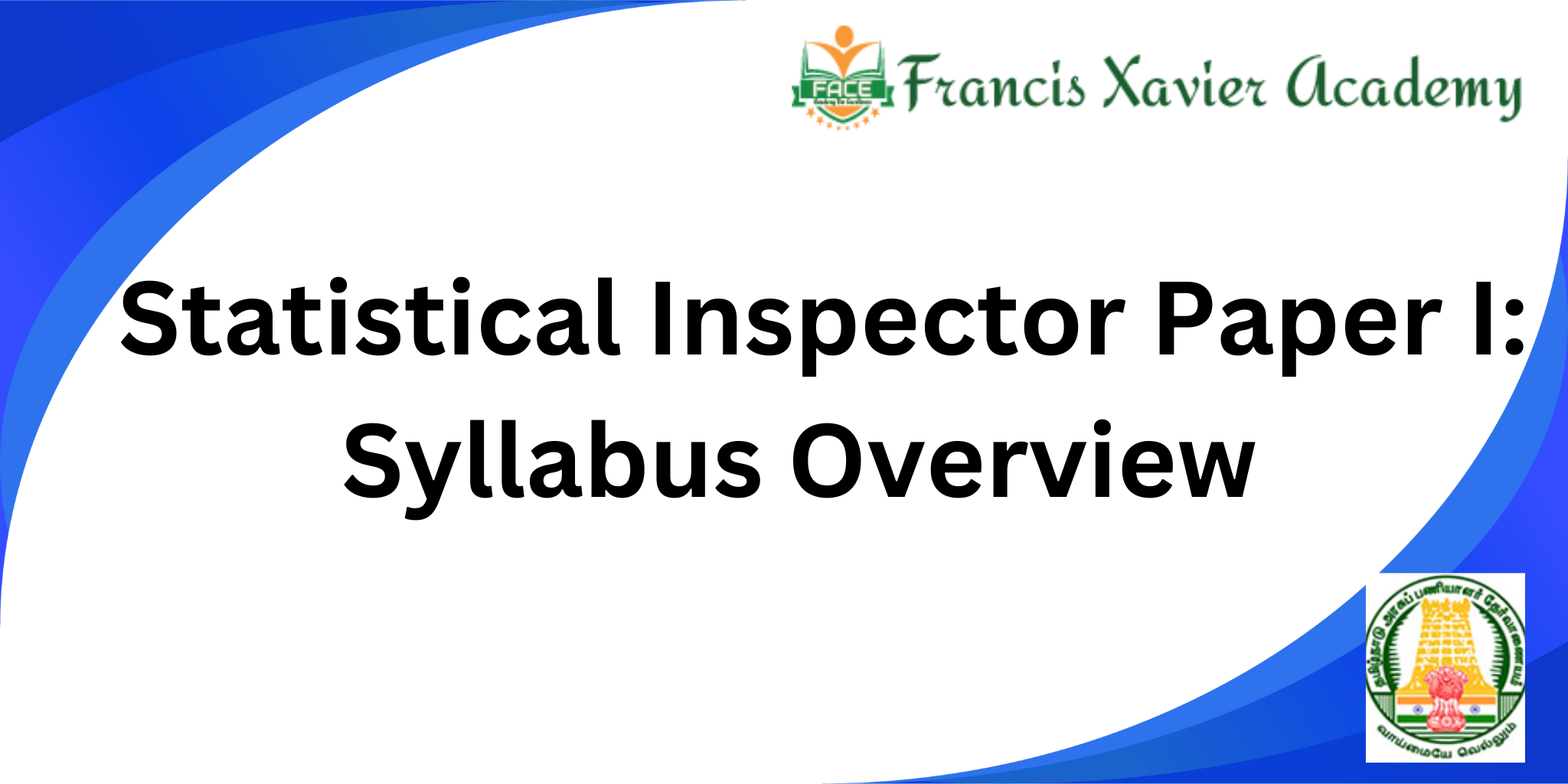
The Tamil Nadu Public Service Commission (TNPSC) Statistical Inspector Exam requires a strong understanding of UG Standard Statistics. First and foremost, this exam assesses candidates’ knowledge of statistical concepts, making it essential to have a well-structured preparation plan. Moreover, since the syllabus covers both theoretical and practical aspects, aspirants must focus on understanding core principles while also practicing problem-solving techniques. In addition, familiarity with statistical tools and software can provide a significant advantage. Therefore, this blog presents a comprehensive and structured overview of the TNPSC Statistical inspector Paper I guide aiming to help candidates prepare effectively and confidently.
UNIT I: Fundamentals of Statistics
- Scope, uses, and limitations of statistics.
- Data collection, classification, and tabulation.
- Graphical and diagrammatic data representation.
- Measures of central tendency (mean, median, mode) and dispersion.
- Skewness, kurtosis, correlation, regression, and curve fitting (linear & quadratic).
UNIT II: Probability & Random Variables
- Probability theorems (Addition, Multiplication, and Bayes’ Theorem).
- Tchebychev’s inequality.
- Univariate and bivariate random variables.
- Probability distributions: Marginal & conditional.
- Expectations, moments, and cumulant generating functions.
UNIT III: Probability Distributions & Sampling
- Discrete Distributions: Binomial, Poisson, Geometric, and Hypergeometric.
- Continuous Distributions: Uniform, Exponential, and Normal.
- Sampling distributions, standard error, and tests using Student’s t, Chi-square, and F-distributions.
UNIT IV: Estimation Techniques
- Firstly, point estimation and properties of estimators.
- In addition, Neyman-Fisher Factorization theorem (without proof), Cramer-Rao inequality, and Rao-Blackwell theorem.
- Moreover, maximum Likelihood Estimation (MLE) and Method of Moments.
- Finally, Interval estimation for mean and variance (small & large samples).
UNIT V: Hypothesis Testing
- Null and alternative hypotheses, types of errors, and power of tests.
- Neyman-Pearson Lemma, UMP tests, and Likelihood Ratio Tests.
- Chi-square test for independence and goodness of fit.
UNIT VI: Sampling & Experimental Design
- Sampling methods: Simple Random, Stratified, Systematic, and Cluster Sampling.
- Errors in surveys: Sampling vs. Non-Sampling errors.
- ANOVA (CRD, RBD, LSD) and Factorial Experiments (2², 2³, 3² without confounding).
- Missing plot techniques.
UNIT VII: Statistical Quality Control & Operations Research
- Firstly, SQC: Control Charts (X̄, R, p, np).
- In addition, acceptance sampling plans (Single & Double) and OC curves.
- Finally, OR Models: Linear Programming (Simplex, Dual-Primal), Assignment Problems, Network Models (CPM & PERT).
UNIT VIII: Time Series Analysis
- Components: Trend and Seasonal variations.
- Methods for detecting and eliminating trends.
UNIT IX: Index Numbers & Demographics
- Construction and uses of index numbers.
- Simple & weighted index numbers, reversal tests, and cost of living index.
- Birth & death rates, fertility rates, life tables.
UNIT X: Statistical Computing
- Using Excel for statistical analysis.
- Overview of SPSS, MINITAB, and SAS software.
Preparation Tips for Aspirants
- Firstly, master Fundamental Concepts – Focus on probability, estimation, and hypothesis testing.
- In addition, practice Problem Solving – Solve previous years’ question papers.
- Moreover, use Statistical Software – Gain basic proficiency in Excel and SPSS.
- Finally, revise Regularly – Create formula sheets and summary notes.
In conclusion, the TNPSC Statistical Inspector Paper I Guide provides a comprehensive overview of the syllabus, covering essential statistical concepts and techniques. Therefore, candidates must develop a deep understanding of fundamental concepts, practice problem-solving, and gain familiarity with statistical software. Furthermore, since the syllabus includes theoretical and application-based topics, aspirants should balance conceptual clarity with practical problem-solving skills.
Moreover, as the exam requires a systematic approach, it is crucial to organize study schedules, revise regularly, and solve previous years’ question papers. Additionally, leveraging statistical tools such as Excel, SPSS, and MINITAB can enhance data analysis skills, thereby improving efficiency in handling statistical computations.
Thus, with dedication, structured study methods, and continuous practice, aspirants can confidently approach the TNPSC Statistical Inspector Exam and achieve their goal of securing the position.
Best wishes for your preparation! Keep learning, stay focused, and excel in your journey.
General studies syllabus for TNPSC Statistical Inspector
 Now
Now